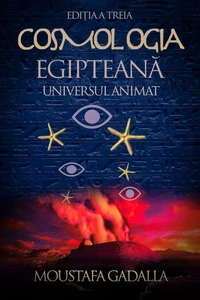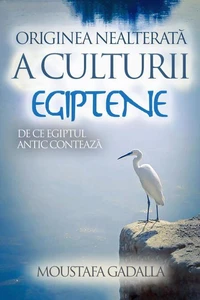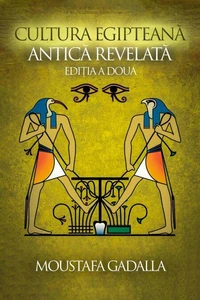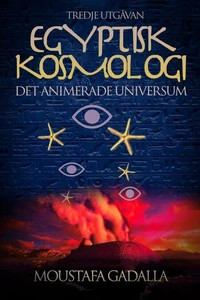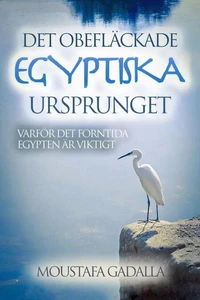Egyptian Divinities: The All Who Are the One
Par :Formats :
Disponible dans votre compte client Decitre ou Furet du Nord dès validation de votre commande. Le format ePub est :
- Compatible avec une lecture sur My Vivlio (smartphone, tablette, ordinateur)
- Compatible avec une lecture sur liseuses Vivlio
- Pour les liseuses autres que Vivlio, vous devez utiliser le logiciel Adobe Digital Edition. Non compatible avec la lecture sur les liseuses Kindle, Remarkable et Sony
 , qui est-ce ?
, qui est-ce ?Notre partenaire de plateforme de lecture numérique où vous retrouverez l'ensemble de vos ebooks gratuitement
Pour en savoir plus sur nos ebooks, consultez notre aide en ligne ici
- FormatePub
- ISBN978-1-931446-58-7
- EAN9781931446587
- Date de parution25/04/2017
- Protection num.pas de protection
- Infos supplémentairesepub
- ÉditeurMoustafa Gadalla
Résumé
Details more than 80 Egyptian divinities(gods, goddesses) and their specific roles. This Expanded Version of the book consists of two Parts with a total of 12 Chapters. Part I : The All Who Are THE ONE consists of seven chapters 1 through 7, as follows:Chapter 1: The One is ALL explains that far from being a primitive, polytheistic form, the Egyptians' ideology is the highest expression of monotheistic mysticism.
Chapter 2: The Divine Energies of The Creation Cycle covers the role of the divine energies in the creation cycle which accords with scientific principles; and how such divine energies were recognized in later creeds as 'Angels of God'. Chapter 3: Manifestation of Neteru in The Orderly Creation Process covers such manifestation into three primary phases, in the Egyptian creation process accounts. Chapter 4: Understanding Names, Epithets & Titles covers the real secret names and how Egyptians used epithets and titles when referring to the divine energies.
Chapter 5: Narration of Their Manifestations explains how the cosmological knowledge of Ancient Egypt was expressed in a story form, which is a superior means for expressing both physical and metaphysical concepts. Chapter 6: Common Misrepresentations of the Divinities in Egypt covers examples of such misrepresnations and provides the real intended representationsChapter 7: Man and The Divine Forces covers man's place in the universal order .
Part II : The Roles of Most Recognized Neteru consists of five chapters 8 through 12, as follows:Chapter 8: Mystical Pictorial Depictions covers pictorial symbolism of the Neteru. Chapter 9: Most Common Animals and Birds Forms Neteru covers the metaphysical significance of several animal images such as that of the ass, baboon, beetle, Bennu/Benben, bulls, cat, cows ;, crocodile, dog, egg, falcon, feather, fish, frog, goose, hare, heron, hippopotamus, horse, ibis, lions [lion, lioness & twin-lions(Aker)], Phoenix, rams, serpents, stork, vulture, and winged sun.
Chapter 10: Most Common Male & Androgynous Human Forms Divinities covers the metaphysical significance of several male and androgynous human form images such as:Amon, Anubis (Anbu, Ubuat , Web-wawet), Apis(Epaphus, Hapis), Aton (Adon), Atum (Atem, Atom, Atam), Bes, Geb(Seb, Keb), Hapi (Hepr), Herishef , Horus Khepri (Khepera), Khnum, Khonsu(Khons), Min(Menu, Amsi, Kamutef), Nefertum --[also, The Triad Ptah-Sokaris-Nefertum], Nun/Nu/Ny, Osiris (Ausar, Usire, Asar), Ptah (Phtas, Vulcan), Re (Ra), Re Hor akhti (Rahorakhty), Reshpu(Reshef, Reseph), Sebek , (Sobek, Suchos), Seth(Set, Sutekh, Typhon), Sokaris, Shu, and ThothChapter 11: Most Common Female Human Forms Divinities covers the metaphysical significance of several female human form images such as: Isis (Auset, Ast)-- The divine female Principle/Principal, Anat, Bast (Bastet, Oubastis), Heket(Heqet), Hathor (Het-Hor, Het-Heru, Venus, Aphrodite) --[also- Mehet-Uret (Mehurt, Methyer)- Heru-sekha- Hesat - Merit- Tree Netrt(goddess) - Astrate/ Asera / Serah / Sarah- Notre Dame], Kadesh (Qadesh), Maat(Mayet), Merit, Mut, Nephthys (Nebt-het), Neith (Net), Nut, Satis (Satet), Sekhmet(Sekh-Mut, Sakhmet, Petesachmis), Selkis(Serket, Selkit, Serqet), Seshat(Safkhet, Sesat, Seshet, Sesheta, Seshata), Taurt(Taweret, Thoeris, Toeris), and Tefnut, Chapter 12: The Archetypal Synergies covers the complex and shifting array ofrelationships between the divine energies; and how such synergies are being manifested in various associations such as dualities, trinities, octads and Enneads.
Chapter 2: The Divine Energies of The Creation Cycle covers the role of the divine energies in the creation cycle which accords with scientific principles; and how such divine energies were recognized in later creeds as 'Angels of God'. Chapter 3: Manifestation of Neteru in The Orderly Creation Process covers such manifestation into three primary phases, in the Egyptian creation process accounts. Chapter 4: Understanding Names, Epithets & Titles covers the real secret names and how Egyptians used epithets and titles when referring to the divine energies.
Chapter 5: Narration of Their Manifestations explains how the cosmological knowledge of Ancient Egypt was expressed in a story form, which is a superior means for expressing both physical and metaphysical concepts. Chapter 6: Common Misrepresentations of the Divinities in Egypt covers examples of such misrepresnations and provides the real intended representationsChapter 7: Man and The Divine Forces covers man's place in the universal order .
Part II : The Roles of Most Recognized Neteru consists of five chapters 8 through 12, as follows:Chapter 8: Mystical Pictorial Depictions covers pictorial symbolism of the Neteru. Chapter 9: Most Common Animals and Birds Forms Neteru covers the metaphysical significance of several animal images such as that of the ass, baboon, beetle, Bennu/Benben, bulls, cat, cows ;, crocodile, dog, egg, falcon, feather, fish, frog, goose, hare, heron, hippopotamus, horse, ibis, lions [lion, lioness & twin-lions(Aker)], Phoenix, rams, serpents, stork, vulture, and winged sun.
Chapter 10: Most Common Male & Androgynous Human Forms Divinities covers the metaphysical significance of several male and androgynous human form images such as:Amon, Anubis (Anbu, Ubuat , Web-wawet), Apis(Epaphus, Hapis), Aton (Adon), Atum (Atem, Atom, Atam), Bes, Geb(Seb, Keb), Hapi (Hepr), Herishef , Horus Khepri (Khepera), Khnum, Khonsu(Khons), Min(Menu, Amsi, Kamutef), Nefertum --[also, The Triad Ptah-Sokaris-Nefertum], Nun/Nu/Ny, Osiris (Ausar, Usire, Asar), Ptah (Phtas, Vulcan), Re (Ra), Re Hor akhti (Rahorakhty), Reshpu(Reshef, Reseph), Sebek , (Sobek, Suchos), Seth(Set, Sutekh, Typhon), Sokaris, Shu, and ThothChapter 11: Most Common Female Human Forms Divinities covers the metaphysical significance of several female human form images such as: Isis (Auset, Ast)-- The divine female Principle/Principal, Anat, Bast (Bastet, Oubastis), Heket(Heqet), Hathor (Het-Hor, Het-Heru, Venus, Aphrodite) --[also- Mehet-Uret (Mehurt, Methyer)- Heru-sekha- Hesat - Merit- Tree Netrt(goddess) - Astrate/ Asera / Serah / Sarah- Notre Dame], Kadesh (Qadesh), Maat(Mayet), Merit, Mut, Nephthys (Nebt-het), Neith (Net), Nut, Satis (Satet), Sekhmet(Sekh-Mut, Sakhmet, Petesachmis), Selkis(Serket, Selkit, Serqet), Seshat(Safkhet, Sesat, Seshet, Sesheta, Seshata), Taurt(Taweret, Thoeris, Toeris), and Tefnut, Chapter 12: The Archetypal Synergies covers the complex and shifting array ofrelationships between the divine energies; and how such synergies are being manifested in various associations such as dualities, trinities, octads and Enneads.
Details more than 80 Egyptian divinities(gods, goddesses) and their specific roles. This Expanded Version of the book consists of two Parts with a total of 12 Chapters. Part I : The All Who Are THE ONE consists of seven chapters 1 through 7, as follows:Chapter 1: The One is ALL explains that far from being a primitive, polytheistic form, the Egyptians' ideology is the highest expression of monotheistic mysticism.
Chapter 2: The Divine Energies of The Creation Cycle covers the role of the divine energies in the creation cycle which accords with scientific principles; and how such divine energies were recognized in later creeds as 'Angels of God'. Chapter 3: Manifestation of Neteru in The Orderly Creation Process covers such manifestation into three primary phases, in the Egyptian creation process accounts. Chapter 4: Understanding Names, Epithets & Titles covers the real secret names and how Egyptians used epithets and titles when referring to the divine energies.
Chapter 5: Narration of Their Manifestations explains how the cosmological knowledge of Ancient Egypt was expressed in a story form, which is a superior means for expressing both physical and metaphysical concepts. Chapter 6: Common Misrepresentations of the Divinities in Egypt covers examples of such misrepresnations and provides the real intended representationsChapter 7: Man and The Divine Forces covers man's place in the universal order .
Part II : The Roles of Most Recognized Neteru consists of five chapters 8 through 12, as follows:Chapter 8: Mystical Pictorial Depictions covers pictorial symbolism of the Neteru. Chapter 9: Most Common Animals and Birds Forms Neteru covers the metaphysical significance of several animal images such as that of the ass, baboon, beetle, Bennu/Benben, bulls, cat, cows ;, crocodile, dog, egg, falcon, feather, fish, frog, goose, hare, heron, hippopotamus, horse, ibis, lions [lion, lioness & twin-lions(Aker)], Phoenix, rams, serpents, stork, vulture, and winged sun.
Chapter 10: Most Common Male & Androgynous Human Forms Divinities covers the metaphysical significance of several male and androgynous human form images such as:Amon, Anubis (Anbu, Ubuat , Web-wawet), Apis(Epaphus, Hapis), Aton (Adon), Atum (Atem, Atom, Atam), Bes, Geb(Seb, Keb), Hapi (Hepr), Herishef , Horus Khepri (Khepera), Khnum, Khonsu(Khons), Min(Menu, Amsi, Kamutef), Nefertum --[also, The Triad Ptah-Sokaris-Nefertum], Nun/Nu/Ny, Osiris (Ausar, Usire, Asar), Ptah (Phtas, Vulcan), Re (Ra), Re Hor akhti (Rahorakhty), Reshpu(Reshef, Reseph), Sebek , (Sobek, Suchos), Seth(Set, Sutekh, Typhon), Sokaris, Shu, and ThothChapter 11: Most Common Female Human Forms Divinities covers the metaphysical significance of several female human form images such as: Isis (Auset, Ast)-- The divine female Principle/Principal, Anat, Bast (Bastet, Oubastis), Heket(Heqet), Hathor (Het-Hor, Het-Heru, Venus, Aphrodite) --[also- Mehet-Uret (Mehurt, Methyer)- Heru-sekha- Hesat - Merit- Tree Netrt(goddess) - Astrate/ Asera / Serah / Sarah- Notre Dame], Kadesh (Qadesh), Maat(Mayet), Merit, Mut, Nephthys (Nebt-het), Neith (Net), Nut, Satis (Satet), Sekhmet(Sekh-Mut, Sakhmet, Petesachmis), Selkis(Serket, Selkit, Serqet), Seshat(Safkhet, Sesat, Seshet, Sesheta, Seshata), Taurt(Taweret, Thoeris, Toeris), and Tefnut, Chapter 12: The Archetypal Synergies covers the complex and shifting array ofrelationships between the divine energies; and how such synergies are being manifested in various associations such as dualities, trinities, octads and Enneads.
Chapter 2: The Divine Energies of The Creation Cycle covers the role of the divine energies in the creation cycle which accords with scientific principles; and how such divine energies were recognized in later creeds as 'Angels of God'. Chapter 3: Manifestation of Neteru in The Orderly Creation Process covers such manifestation into three primary phases, in the Egyptian creation process accounts. Chapter 4: Understanding Names, Epithets & Titles covers the real secret names and how Egyptians used epithets and titles when referring to the divine energies.
Chapter 5: Narration of Their Manifestations explains how the cosmological knowledge of Ancient Egypt was expressed in a story form, which is a superior means for expressing both physical and metaphysical concepts. Chapter 6: Common Misrepresentations of the Divinities in Egypt covers examples of such misrepresnations and provides the real intended representationsChapter 7: Man and The Divine Forces covers man's place in the universal order .
Part II : The Roles of Most Recognized Neteru consists of five chapters 8 through 12, as follows:Chapter 8: Mystical Pictorial Depictions covers pictorial symbolism of the Neteru. Chapter 9: Most Common Animals and Birds Forms Neteru covers the metaphysical significance of several animal images such as that of the ass, baboon, beetle, Bennu/Benben, bulls, cat, cows ;, crocodile, dog, egg, falcon, feather, fish, frog, goose, hare, heron, hippopotamus, horse, ibis, lions [lion, lioness & twin-lions(Aker)], Phoenix, rams, serpents, stork, vulture, and winged sun.
Chapter 10: Most Common Male & Androgynous Human Forms Divinities covers the metaphysical significance of several male and androgynous human form images such as:Amon, Anubis (Anbu, Ubuat , Web-wawet), Apis(Epaphus, Hapis), Aton (Adon), Atum (Atem, Atom, Atam), Bes, Geb(Seb, Keb), Hapi (Hepr), Herishef , Horus Khepri (Khepera), Khnum, Khonsu(Khons), Min(Menu, Amsi, Kamutef), Nefertum --[also, The Triad Ptah-Sokaris-Nefertum], Nun/Nu/Ny, Osiris (Ausar, Usire, Asar), Ptah (Phtas, Vulcan), Re (Ra), Re Hor akhti (Rahorakhty), Reshpu(Reshef, Reseph), Sebek , (Sobek, Suchos), Seth(Set, Sutekh, Typhon), Sokaris, Shu, and ThothChapter 11: Most Common Female Human Forms Divinities covers the metaphysical significance of several female human form images such as: Isis (Auset, Ast)-- The divine female Principle/Principal, Anat, Bast (Bastet, Oubastis), Heket(Heqet), Hathor (Het-Hor, Het-Heru, Venus, Aphrodite) --[also- Mehet-Uret (Mehurt, Methyer)- Heru-sekha- Hesat - Merit- Tree Netrt(goddess) - Astrate/ Asera / Serah / Sarah- Notre Dame], Kadesh (Qadesh), Maat(Mayet), Merit, Mut, Nephthys (Nebt-het), Neith (Net), Nut, Satis (Satet), Sekhmet(Sekh-Mut, Sakhmet, Petesachmis), Selkis(Serket, Selkit, Serqet), Seshat(Safkhet, Sesat, Seshet, Sesheta, Seshata), Taurt(Taweret, Thoeris, Toeris), and Tefnut, Chapter 12: The Archetypal Synergies covers the complex and shifting array ofrelationships between the divine energies; and how such synergies are being manifested in various associations such as dualities, trinities, octads and Enneads.




